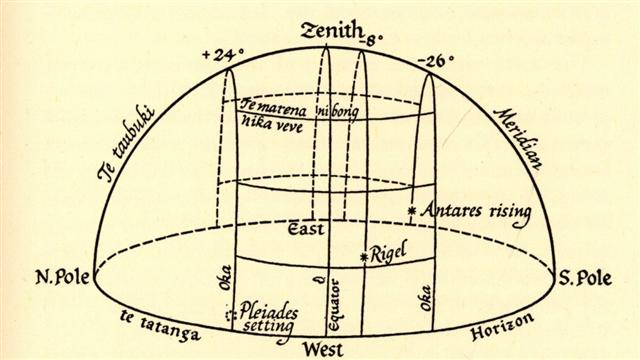5. Possibly the important signs are not pictorial but structural. Possibly each tablet is a kind of 'time-piece', created to document the cycles of time-space, and maybe the picturesque glyphs are there just in order to make it easier to perceive the cardinal points. If, for instance, everyone knew that Tagaroa was alone at the very beginning, an infant god without companions and without any light to guide him, crammed into a shell, a situation easy to imagine and remember, then it would be natural to search for him among the glyphs on a tablet. From such a point of reference, like a beacon in the dark (or Sirius), orientation could proceed by counting glyphs. The 'egg' year should be 20 * 20 = 400 days long:
417 = 400 + 17 and 17, we know, indicates the beginning of something knew. A year of 'light' ('ebb') should end in 'inundation' ('flood'), and henua in Gb7-6 is of the type which I have earlier provisionally called 'midnight henua' in order to distinguish it from the prototype I have chosen for the glyph type henua:
In the 'calendar of night' of Tahua this variant of henua (in Aa1-43) was named raaraa by Metoro:
Among the 12 glyphs it has position 7, i.e. it is the first glyph of the 2nd half - although Metoro read the pair Aa1-42--43 as a unit, probably to indicate a division of the night into 7 + 5 hours. I guessed Aa1-43 referred to midnight. My later experiences confirmed the location of this type of glyph to the center of the dark 'night', standing like a pole in the middle of the 'sea'. It is time to give this 'midnight henua' a genuine glyph type label, and I have chosen it to be raaraa:
Vale levu (= hare rehu), the chiefly house, could correspond to Rehua (Antares), in which case Antares should represent the last day of the old year with the next day as the first day of the new year (the ceremonial ground, raaraa):
According to the Gilbertise sky map Antares defines the southern border of a 'band of light', 18° broad from Rigel:
Raaraa is the negative of raa, i.e. it is the opposite of day (Sun, etc). The sails of the Sun boat have been pulled down. If we allot 10 days for each degree of 'latitude' the 'band of light' becomes 10 * (26 - 8) = 180 days. 8 * 20 = 160 days could be added from the equator to Rigel resulting in 160 + 180 = 240 = ⅔ of 360 days. From the other side of the equator each degree of latitude could correspond to 5 days, because 360 - 240 = 120 = 5 * 24. But so this is pure speculation, of course. |
||||||||||||||||||||||||||||||||||||||||||||||||||||||||||||||||||||||||||||||||||||||||||||||||




